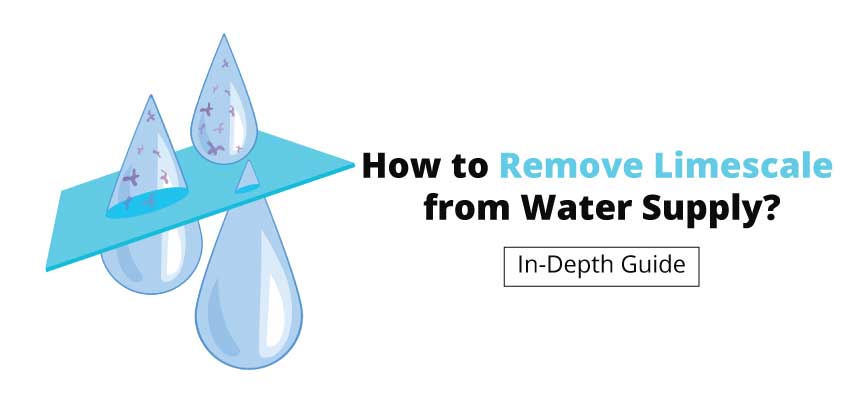Limescale, known as calcium carbonate, is something people like to acknowledge as a severe water problem.
The water with pH 7 is considered the best among all. Calcium carbonate is basic, and do you know what that even counts for?
The water will no longer remain neutral as the pH level rises above 7 and can be up to 14, which needs to be neutralized using acids.
Again, some people don’t know about suitable acids, and we got your back for those reasons!
Acid-base neutralization principle goes well with mild acids, such as acetic acid, citric acid, or the acid from washing soda which dissolves very well with limescale. Thus neutralization occurs, which brings the pH to a standard level, and water gets purified. Moreover, you can use a water filter that removes limescale as it is the easiest and cheapest solution.
Read till the end to learn more about removing limescale from your plumbers or water supply.
How to remove limescale from the water supply?
Limescale is another form of hard water which is more stubborn and more brutal to deal with. This is because when hard water rich with minerals gets evaporated, the calcium and magnesium contents of the water remain as residue, causing limescale.
And who would have ever wanted those white, complex, and sticky fluid substances to be present in their edible and usable water supply?
And, thus we end up with the top methods of getting rid of limescale from water supplies which are as follows-
Distilled Vinegar Solution:
4-7% solution of acetic acid is known as distilled white vinegar. Regular vinegar or 6-8% solution of acetic acid can also be used as the main rule of thumb here is to combine acids with excess bases present in water due to limescale.
Depending on the amount of limescale present, the acid concentration also increases. Weak acids are generally preferred to be best for removing calcium carbonate as strong acids may end up damaging other resources or turning the water pH level too low.
Due to limescale, if the water pH is between 7 to 10, use distilled white vinegar for an easy go. If it’s higher than ten or nearer to 14, you will be going for slightly higher numbers of acetic acid so that the water neither remains higher than the pH level of 7 nor below it.
The usage of this vinegar addition method can vary depending on the circumstances-
- Appliances:
If traces of limescale are found in your washing machine and dishwasher, running vinegar a couple of times can help.
- Fixtures:
If the buildups are visible on the institutions, removing the drain plugs and showerheads and soaking them in a bucket full of vinegar and water solution will show efficient results. If the removal is not possible, one can fill zip lock bags with vinegar and place them on the fixture’s heads and make them stay for some hours.
- Lemon juice:
The good news is that calcium carbonates dissolve in a range of mild and weak acids, making a lemon no less effective! Lemon contains citric acid, which is edible and causes no harm when mixed in water.
Out of many brand-limescale removers, a simple kitchen ingredient like lemon juice can work miracles but needs some time. Cleaning water appliances with a cloth soaked with lemon juice would not be enough to remove that strong limescale.
Soaking lemon juices in cotton pads, wrapping them around those places with limescale buildup, and keeping them for an hour is recommended. Squeezing can also be done so that the acids spread all over the area.
- Water softener:
Not cleaning out your plumbing systems for years can exacerbate the hard water because of the accumulation of too many minerals. It causes excessive limescale in your water supply, which often becomes tougher to deal with regular acids.
But, it’s our habit of coming up with the good news that a water softener can be used in such cases.
A water softener and limescale filter work by bubbling pressurized carbon dioxide into the water filled with limescale to lower the pH level.
A higher sodium ion is caused by a water softener displacing minerals like magnesium and calcium from the water.
Too much water softener should be avoided as it can lower the water pH at an exceeding rate and cause the water to become acidic.
Similar Blogs:
Best Water Filter For PFAS (Read Here)
Does Water Filter Remove Chlorine? (Read Here)
What are the Best Glass Water Filter Pitchers (Read Here)
FAQ: Related Asked Question
Q. Which acid works most quickly on limescale?
Hydrochloric (HCL), or the one present inside our stomach, is best in removing limescale in the shortest amount of time due to pH levels lower than 3.
Q. How do professional cleaners remove limescale?
For the best results in less time and care, professional cleaners combine vinegar and borax in a 50-50 composition. With that solution, they scrub limescale-affected areas and remove them.
Conclusion:
All those impurities in water that can’t be gotten rid of by boiling are due to the imbalances in pH and acid-base compositions, for example, the limescale in water.
The methods we discussed earlier, the prevention of water, like using vinegar or water softener, can themselves become the reason for water pollution when done excessively. In that case, limescale itself can be used to balance out.
Again, excessive contents of limescale require acids at certain levels, and thus, the coordination continues

